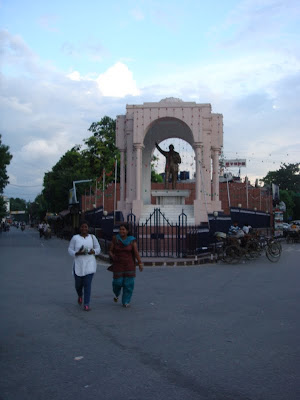Lucknow ( Hindi: लखनऊ, Urdu: لکھنؤ, Lakhnau ) is the capital city of Uttar Pradesh, the most populous state of India. Lucknow is also the administrative headquarters of Lucknow District and Lucknow Division.
Located in what was historically known as the Awadh region, Lucknow has always been a multicultural city. Courtly manners, beautiful gardens, poetry, music, and fine cuisine patronized by the Persian-loving Shia Nawabs of the city are well known amongst Indians and students of South Asian culture and history. Lucknow is popularly known as the The City of Nawabs. It is also known as the Golden City of the East, Shiraz-i-Hind and The Constantinople of India.
Today, Lucknow is a vibrant city that is witnessing an economic boom and is among the top ten fastest growing non-major-metropolitan cities of India. It is the second largest city in Uttar Pradesh state. The unique combination of its cultured grace and newly acquired pace is its most promising feature that augurs well for the future.
Located in what was originally known as the Awadh (Oudh) region, Lucknow has always been a multicultural city, and flourished as a cultural and artistic capital of North India in the 18th & 19th centuries. Courtly manners, beautiful gardens, poetry, music, and fine cuisine patronized by the Persian-loving Shia Nawabs of the city are well known amongst Indians and students of South Asian culture and history.Lucknow is popularly known as The City of Nawabs. It is also known as the Golden City of the East, Shiraz-i-Hind and The Constantinople of India.
Lucknow is placed among the fastest growing cities and now it is metropolitan city of India and is rapidly emerging as a manufacturing, commercial and retailing hub. This unique combination of rich cultural traditions and brisk economic growth provides Lucknow with an aura that refuses to fade away.
Lucknow has Asia's first human DNA bank. This is world's second bank having DNA identification system (DIS) and has been established in the Biotech park under the public private partnership with IQRA Biotech Services.
Modern Lucknow is a bustling metropolis. Historically, it was a centre of Urdu literature.
Nawab Asaf-Ud-Dowlah (1775-1797)[11]After 1350 AD the Lucknow and parts of Awadh region have been under the rule of the Delhi Sultanate, the Mughal Empire, the Nawabs of Awadh, the East India Company and the British Raj. Lucknow has been one of the major centers of Indian rebellion of 1857, participated actively in India's Independence movement, and after Independence has emerged as an important city of North India.
Until 1719, subah of Awadh was a province of the Mughal Empire administered by a Governor appointed by the Emperor. Saadat Khan also called Burhan-ul-Mulk a Persian adventurer was appointed the Nazim of Awadh in 1722 and he established his court in Faizabad[12] near Lucknow.
Awadh was known as the granary of India and was important strategically for the control of the Doab, the fertile plain between the Ganges and the Yamuna rivers. It was a wealthy kingdom, able to maintain its independence against threats from the Marathas, the British and the Afghans. The third Nawab, Shuja-ud-Daula fell out with the British after aiding Mir Qasim, the fugitive Nawab of Bengal. He was comprehensively defeated in the Battle of Buxar by the East India Company, after which he was forced to pay heavy penalties and cede parts of his territory. The British appointed a resident in 1773, and over time gained control of more territory and authority in the state. They were disinclined to capture Awadh outright, because that would bring them face to face with the Marathas and the remnants of the Mughal Empire.
Many independent kingdoms, such as Awadh, were established when the Mughal empire disintegrated. Awadh’s capital, Lucknow rose to prominence when Asaf-ud-Daula, the fourth nawab, shifted his court here from Faizabad in 1775. The city was also North India’s cultural capital, and its nawabs, best remembered for their refined and extravagnt lifestyles, were patrons of the arts. Under them music and dance flourished, and many monuments were erected.[13] Of the monuments standing today, the Bara Imambara, the Chhota Imambara, and the Rumi Darwaza are notable examples. One of the more lasting contributions by the Nawabs is the syncretic composite culture that has come to be known as the Ganga-Jamuni Tehzeeb.
Nawab Saadat Khan IIIn 1798, the fifth Nawab Wazir Ali Khan alienated both his people and the British, and was forced to abdicate. The British then helped Saadat Ali Khan to the throne. Saadat Ali Khan was a puppet king, who in the treaty of 1801 ceded half of Awadh to the British East India Company and also agreed to disband his troops in favor of a hugely expensive, British-run army. This treaty effectively made the state of Awadh a vassal to the British East India Company, though it notionally continued to be part of the Mughal Empire in name until 1819.
Wajid Ali Shah (1847 - 1856)[11]In 1856 the East India Company first moved its troops to the border, then annexed the state, which was placed under a chief commissioner - Sir Henry Lawrence. Wajid Ali Shah, the then Nawab, was imprisoned, and then exiled by the Company to Calcutta. In the subsequent Revolt of 1857 his 14-year old son Birjis Qadra son of Begum Hazrat Mahal was crowned ruler, and Sir Henry Lawrence killed in the hostilities. Following the rebellion's defeat, Begum Hazrat Mahal and other rebel leaders obtained asylum in Nepal
Those company troops who were recruited from the state, along with some of the nobility of the state, were major players in the events of 1857. The rebels took control of Awadh, and it took the British 18 months to reconquer the region, months which included the famous Siege of Lucknow. Oudh was placed back under a chief commissioner, and was governed as a British province. In 1877 the offices of lieutenant-governor of the North-Western Provinces and chief commissioner of Oudh were combined in the same person; and in 1902, when the new name of United Provinces of Agra and Oudh was introduced, the title of chief commissioner was dropped, though Oudh still retained some marks of its former independence.
The province of Awadh (anglicized to Oudh) was annexed by the East India Company in 1856 under the Doctrine of Lapse and placed under the control of a chief commissioner. In the Indian Rebellion of 1857 (also known as the First War of Indian Independence and the Indian Mutiny), the garrison based at the Residency in Lucknow was besieged by rebel forces. The famous Siege of Lucknow was relieved first by forces under the command of Sir Henry Havelock and Sir James Outram, followed by a stronger force under Sir Colin Campbell. Today, the ruins of the Residency, and the picturesque Shaheed Smarak offer reminiscences of Lucknow's role in the stirring events of 1857.
Because of its historical importance, commercial activity, and cultural activity, Lucknow has frequently been a center of political activity, prominent in the independence movement. The Lucknow Pact of 1916 was negotiated there, between the Indian National Congress and the Muslim League to support pressuring the Raj for greater autonomy, a marked shift for the Muslim League.
The Khilafat Movement had an active base of support in Lucknow, creating a united platform against the British rule. In the Khilafat Movement Maulana Abdul Bari of Firangi Mahal, Lucknow actively participated and cooperated with Mahatama Gandhi and Maulana Mohammad Ali.
In 1901, after remaining the capital of Oudh since 1775, Lucknow, with a population of 264,049, was merged in the newly formed United Provinces of Agra and Oudh.[14] However, it became the provincial capital in 1920 when the seat of government was moved from Allahabad. Upon Indian independence in 1947, Lucknow became the capital of Uttar Pradesh, the erstwhile United Provinces
_______________________
I have drawn the above information from Wikipedia and other sources. Here are some photos I took while in the city
























8 Fertilize my soul:
Lucknow in Your camera looks like mix of European and Asian city. It must be really interesting for visitors, it's long history must have some traces.
Hello, Amrita. I've just watched the Pope on my tv while he prayed the Via Crucis in the streets of Madrid -he is in Spain right now, to the Youth Meeting (1 and a half million young people in our capital this evening, ufffff!). I think you would like to know it.
Smiles from Spain.
María del Mar Hermoso
arabescoazul.blogspot.com
teselasoflife.blogspot.com
Interesting. The East India Company was more interested in money than in letting the glad tidings come to the Indians, I'm afraid.
Hi Zim, its interesting you noticed that. The older building are influenced by British archetecture, in my city too.
Hi Maria, that ' a lot of people coming to welcome th e Pope, I am clad the young people are interested in a religious event. May God blss the peope of Spain
Dear David, the East India Company was initially a trading company
Dear Amrita,
I have to thank you over and over again for broadening my horizon.
History is so important for those who want to understand the contemporary.
India for sure has a violent and colourful past brought into the leading nations of the world by those who have learned from the past and respects the need for knowledge and science.
I remember reading a book in the fifties, "The road to Agra." Written by a Norwegian author, but describing the hardships of poor children in the outskirts of India.
Funny how great impact the books and stories from ones childhood have even in my old age. I need only to read the word Agra, the the whole story is alive again.
Have a blessed Lord's day from felisol
That book seems to be very interesting to me too Felisol
Post a Comment